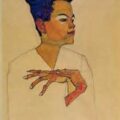So Says My Interiority: Mary Jo Bang’s A Film in Which I Play Everyone

In more ways than one could expect, Mary Jo Bang’s A Film in Which I Play Everyone enacts the intriguing promise of its title, a playful adoption of a quote by David Bowie. When asked by a fan whether he had any film roles, Bowie said that he hoped to finance a biopic of himself in which he plays every character. The ninth collection from Bang, a Gugenheim Fellow and National Book Critics Circle Award winner, draws on film as a point of departure and a source of metaphor—as well as a mirror of meta-perception. Bang is particularly interested in film’s association with cultural conditioning, on the one hand, and reframing through critical and creative thinking on the other. For better or worse, film is something we see in order to learn and relearn to see.
Dreams serve as a kindred counterpoint to film in Bang’s collection, as another kind of medium in which we each play everyone. Some poems engage with dreams themselves, but the speakers also interact with their subjects in the same ways as waking interactions with our own dreams make them matter: attending to hazy waking remembering, reflecting on associations and implications, active imagination, the experience of seeing one’s life from the outside in. Because cultural conditioning is internalized, thinking through dreams often involves seeing through cultural constructions as a method of self-reflection.
Film and dreams both correspond with a dramatic basis of understanding the psyche. This includes various integrations of the organic roles of speaker, reader, and other into the poems’ explorations of the workings of psyche in and between persons. Indeed, the poems work to “play everyone” until these figures each present aspects of one another. In reading across these subtle synapses, we may then drop down through the spaces opened by their elegantly formed movements of mind through mind—to the quiet, disquieting emptiness beneath its making.
Dynamic intra-psychic exchange, in turn, supports the poems’ deep play with language and thought and their creative facilitation of individual and cultural reflection. “From Another Approach” invokes the personifications used in communicating psychological experiences, which are helpful in understanding despite being essentially fictional:
The small but necessary part of the heart that we beg in the middle of the night to calm us with a quieting chorus of “There, there, my similar, there, there.
The poem stages the inner drama of feeling lonely or desperate, including the redoubled suffering in our failed attempts to abate it. The self-comfort becomes ironic. The subtle humor, in seeing through the fantasy, opens to an experience of the feeling itself that actually deepens awareness of being, beyond the fantasy of soothing it away or the idea that one should be able to.
“Here We All Are with Daphne” dramatizes interior reflection within a mythical context, multiplying the metamorphosis by staging the speaker as one of many transformed into trees, “aligned and fixed / like the stars overhead: that limited canopy”. Blurring the distinction between the reader of the myth and the speaker of the poem, Bang suggests a connection between lived experiences and the myth’s central event.
This prepares for two interdependent shifts in focus: first, to modern existential transformations of consciousness; then, to a direct portrayal of the sexism reflected by the original myth.The speaker shows us we all are subject to Daphne’s fate in being locked into interpreting the world through subjectivity’s sometimes painful awareness of its own existential isolation:
We are all dying but some more than most, so says my interiority. It talks to me as green fills the screen. It takes my arm and walks alongside me. I never ask where I’m going. I know I’m not meant to arrive.
The characterization of “my interiority” counterintuitively fits the experiences of inner dialogue, including listening to one’s “interiority,” that the concept collectively describes. These experiences defy abstraction, despite our use of abstractions to discuss those very experiences. The “green” that “fills the screen” evokes a scene shot without background, waiting to be put into context, sometimes more than once. Here it also describes the impossible inner landscape around this dialogue.. We are, after all, continually in the process of locating these existential truths within unfolding experiences.
In light of the myth’s depictions of violence, the green screen may also correspond to the challenge of recalling background detail when remembering trauma. “Walks” with one’s “interiority” in this context could represent reflections that connect the myth to personal experience in mutually edifying and restorative ways as well. The ending’s personification, the blithely dehumanizing Apollo figure, suggests the power sexism’s collective silencing: “’See,’ he said, / ‘isn’t this all for the better? You with no mouth / to speak of?’ By you he meant me.” “The Problem of the Present” instigates a similar dialogue within the reader, prompting the reader to question the validity of previously integrated cultural ideas:
The question is not whether we have free will, but what choices history offers us. The strongest force is conformity, not passion, not even greed for possessions because who would ever want a diamond unless they were told to. Here, someone must have said, you want this.
Liberating though it may be, removing the lenses of personal and cultural illusions relinquishes as it frees. This is in part due to the relationship between consciousness of one’s thoughts and consciousness of death, as “Before the Absolute Perfection Dying Achieves” suggests: “Before we reach // the abyss, time flips from I-didn’t-know then / to what-I-know now”. In the poem’s ending, the speaker shifts to present-tense, while bringing the insight home to the reader:
I am examining the sill as an unbroken line dividing outside from in, knowing that that border also marks the point when living is over. The hour of lead. Imagine it. Could you move? Now you think.
The image of the window echoes the opening insight, that awareness of death corresponds with heightened awareness of separation between perceiver and perceived, inside and outside. The compelling final line dramatizes a shift between the two in the movement from imperative to interrogative to second person.
After staging a confrontation with death, the speaker demands that the reader consider their life in terms of the empty space that follows—literally the space after the poem. Without internalizing the fact of death, the poem suggests, we are never truly thinking.
Attempts to understand life through the self-escaping lens of psyche can also give rise to a sense of adventure. “Sometimes I Come To And Wonder” portrays the cyclic nature of such pursuits and the provisionality of their arrivals:
To be forever inside the revolving universe has never been my dream and yet while I was here, I wanted knowledge. I knew I could see inside myself but no one else could. I had no second self. And If I had? Escape is what one does for an interval before returning to a town
“Dream” here means both the literal unconscious state and the fantasies of waking life. Moving from an imagined ideal future to being present to oneself in the moment leads us to reflect on the experience of “interiority”—presence versus dream—then to “[e]scape” from this pondering to a dreamscape “town.” The irreconcilable interior mystery, one’s ability to “see inside myself” despite having “no second self,” indicates the essential interdependence between inner and outer worlds. Each is a revolving universe that we struggle to understand, and we find respite in each from the other.
Self-reflection through dreams teaches us to interpret our lives as if they were the creative works in progress that they are. “What I’m Covering Over” deepens the implications of these insights. The poem focuses on the need to consider multiple perspectives in consciousness. The title serving as first line is an interesting sign of the lack of truly objective reference point:
What I’m Covering Over is the seething beginning where I saw things but didn’t know what they meant. The touching world kept putting its hands on me. There is no way to replicate what made no sense when it happened. What anything might mean after the fact is simply conjecture. That said, I am still alive inside it and so see it
It’s a Kantian reminder: understanding is produced in the consciousness and in the context of our constructs, it is not merely a product of perception. The poem’s ending also compares interestingly with the previous one:
I only know what I knew and that was firsthand. Its little to nothing keeps me here and makes me think I would know what hell was if there were one outside of this one. Meanwhile, here comes a monster.
Whereas “Sometimes I Come To And Wonder” shows how following “dreams” can open the mind to possibility, here all perception of the alleged “real” world seems monstrous. When the “little to nothing” we know traps us not only in thinking what we see is hell, but also that it is the only hell, the future can only be a monster. This logic would imply that we are all monsters in someone else’s fears. A similar unembellished tone describes both the “gate opening,” and the “monster,” avoiding both catastrophizing and romanticizing. Perhaps the ending wants us to confront these connections along with the speaker in a quiet, self-reflective way, returning through this poem’s “gate” reawakened to our own shadows—and hells.
“Like Someone Asleep in a Cinema” offers a corresponding vision of creative life that is balanced between psychological flexibility and unadorned honesty:
Like someone asleep in a cinema who wakes to lean over into your space and mock your open-eyed wonder. That’s how it was then, the eye movements of others tracking my every reaction on the stage that ends by design sans everything.
Projections crowd the “theatre”: the sleeper projects onto the viewer of the film, which is literally projected onto an empty stage. All of this begins with a simile, the speaker is projecting a comparison onto a period of time marked by a projection of surveillance onto “eye movements of others.” These projections are reclaimed, to a degree, with a present-tense discussion of conscious lying, in various forms:
Every act is literalized. The clock no longer flips number to number, time keeps making a hissing is. Lying is now in fashion. Lie down with me, people say, when they hold someone back from the edge of that insane remembering. Floating out of the mouth is the suds of tomorrow. I will never be clean, not as long as I live. We watch unrealizable shadows and make something of them—an eye watching the lashes fall.
The unsentimental view of “lying down” in therapy to process “insane remembering” replaces the projections with an incisive awareness that sees through even its own psychoanalytical means of self-preservation. Eros appears consigned as a bulwark against utter despair, its connective illusions lost to our “literalized” perspectives.
The poem’s understated hope persists as we attend to our “unrealizable shadows,” creating a chance to “make something of them.” We can now see the need for the humor with which “interiority” was presented earlier. It isn’t that our interior lives are to be dismissed or discounted. On the contrary, humor allows the necessary distance to perceive the more unsettling aspects that can be found there. The punning and psychological dexterity recalibrate an internal equilibrium, recalling the wry and absurdist humor of Bowie’s titular quote.
This balance between playfulness and complexity, vitality and austerity, is an invitation to respond to a confounding world with calm, truthful, even gently humorous assessments of what we cannot know—or change. The varied de-familiarizations of stale understandings in these poems spark intuitive footholds where we may begin. The dreams and meta-perception of inner life provide a model of expansive flexibility of perspective. Reading these poems asks us, guides us, to actually read—critically, creatively, with honesty, and consideration—to read everything with our whole being. In doing so, we continually rediscover the emptiness beneath our constructed selves that is also openness—in which we may actually perceive, listen, think, and create, while we are here.
About Michael Collins
Michael Collins is the author of the chapbooks How to Sing when People Cut off your Head and Leave it Floating in the Water and Harbor Mandala and the full-length collections Psalmandala and Appearances, which was named one of the best indie poetry collections of 2017 by Kirkus Reviews. He teaches creative and expository writing at New York University and has taught at The Hudson Valley Writer’s Center, The Bowery Poetry Club, and several community outreach and children’s centers in Westchester. He is the Poet Laureate of Mamaroneck, NY.





